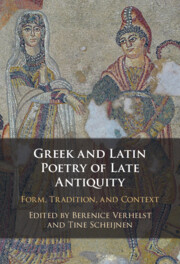Book contents
- Greek and Latin Poetry of Late Antiquity
- Greek and Latin Poetry of Late Antiquity
- Copyright page
- Contents
- Figures
- Contributors
- Introduction
- Part 1 A ‘Late’ Perspective on the Literary Tradition
- Part 2 Late Antique ‘Genres’ and ‘Genre’ in Late Antiquity
- Part 3 The Context of Late Antiquity
- Chapter 8 Saying the Other
- Chapter 9 Internal Audiences in the New Testament Epics of Juvencus and Nonnus
- Chapter 10 Colluthus and Dracontius
- Chapter 11 Objects of the Lusting Gaze
- Chapter 12 Metamorphosis and Mutability in Late Antique Epic
- Bibliography
- General Subject Index
- Index Locorum
Chapter 8 - Saying the Other
The Poetics of Personification in Late Antique Epic
from Part 3 - The Context of Late Antiquity
Published online by Cambridge University Press: 16 June 2022
- Greek and Latin Poetry of Late Antiquity
- Greek and Latin Poetry of Late Antiquity
- Copyright page
- Contents
- Figures
- Contributors
- Introduction
- Part 1 A ‘Late’ Perspective on the Literary Tradition
- Part 2 Late Antique ‘Genres’ and ‘Genre’ in Late Antiquity
- Part 3 The Context of Late Antiquity
- Chapter 8 Saying the Other
- Chapter 9 Internal Audiences in the New Testament Epics of Juvencus and Nonnus
- Chapter 10 Colluthus and Dracontius
- Chapter 11 Objects of the Lusting Gaze
- Chapter 12 Metamorphosis and Mutability in Late Antique Epic
- Bibliography
- General Subject Index
- Index Locorum
Summary
This chapter treats allegory in the Posthomerica in light of late antique thinking on personification. Tracing Quintus’ deployment of the technique, it centres on the shield of Achilles, which contains the fullest personification allegory: the Mountain of Arete. Scholars have focused on the literary-philosophical aspects of this image. I argue that Quintus uses personification self-consciously as a literary device. Drawing on contemporary conceptions of personification from both the Greek and Latin traditions – rhetorical treatises, school exercises and literary works (particularly Prudentius’ Psychomachia, which applies personification full-scale into hexameter verse) –this chapter shows how the Posthomerica reflects ideas in these texts about the inherently duplicitous nature of this mode of writing. Highlighting the tensions in his allegorical configurations, Quintus reveals a sophisticated understanding of personification as a productive but problematic system of divergence and convergence between different worlds and perspectives. By so doing, he advertises limits and challenges of his own poetic creation – a text both rooted in the Homeric past and a product of its time.
Keywords
- Type
- Chapter
- Information
- Greek and Latin Poetry of Late AntiquityForm, Tradition, and Context, pp. 153 - 173Publisher: Cambridge University PressPrint publication year: 2022



